This page has theory test questions about behaviour.
You can use these questions to test yourself, or have a friend or family member test you.
If you don’t know the answer, click on the link underneath the question to find out.
B1 If you are driving at night with your vehicle headlights on high beam, when MUST you dip them?
B2 When passing a horse and rider, what should you do?
Sharing the road with horse riders
B3 If you have to drive at a slow speed that may hold up other vehicles, what should you do?
B4 What are you NOT allowed to do when driving on a motorway?
B5 When a flock of sheep are coming towards you on a country road, what should you do?
B6 What is the recommended distance you should allow when driving past a cyclist?
_____ metres
Sharing the road with cyclists
B7 When following a vehicle on a dusty metal (gravel) road, what should you do?
B8 What should you do when driving in foggy weather?
B9 You are driving downhill on a steep, narrow road and a vehicle is coming up the hill. What should you do?
B10 You MUST you dip the headlights on your vehicle when:
B11 When traffic is merging, what is a good rule to follow?
B12 What is the safest way to carry goods inside a vehicle?
B13 You must NOT open the door of your motor vehicle when:
B14 If you miss your exit on a motorway, you should:
B15 If you are driving and you want to use a cellphone what should you do?
B16 What should you do if the vehicle behind you wishes to pass?
B17 Alcohol slows down your reactions when driving. True or False?
B18 In addition to checking it is safe to move out from the kerb into the traffic flow, what must you do?
B19 Before making a lane change to your left, you must signal for at least 3 seconds. What else must you do?
B20 What should you do when another vehicle is following you very closely?
B21 You wish to move your vehicle out of a parking space into the traffic flow. What must you do before you move?
B22 When driving into bright sunlight, you should use sunglasses and your vehicle sun visors for safety. What else are you advised to do?
B23 What should you do if the vehicle behind you starts to pass you?
B24 You see a pedestrian carrying a white cane crossing the road. What should you do?
Sharing the road with pedestrians
B25 You wish to turn left at the intersection. What should you do?
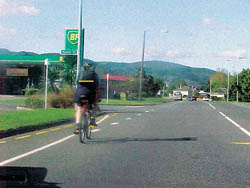
B26 You look in the mirror and see a cyclist. What should you do when opening the car door?
B27 What is the best way to check for hazards before reversing your vehicle?
B28 You are the driver of the blue car. Of the 4 hazards marked, which one is most likely to require you to take urgent action? A, B, C or D?
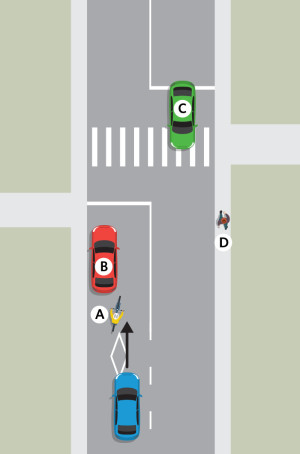
B29 You are the driver of the blue car. Of the 4 hazards marked, which one is most likely to require you to take urgent action? A, B, C or D?
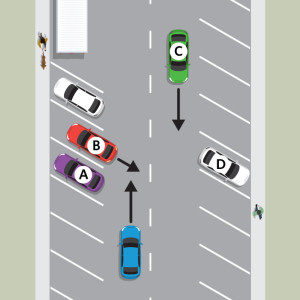
B30 You are the driver of the blue car. Of the 4 hazards marked, which one is most likely to require you to take urgent action? A, B, C or D?
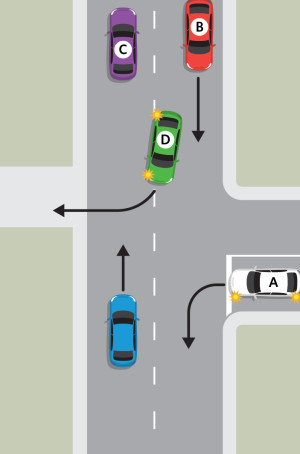
B31 You are the driver of the blue car. Of the 4 hazards marked, which one is most likely to require you to take urgent action? A, B, C or D?
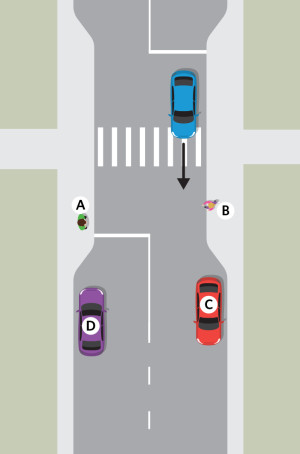
B32 What is the safest way to drive up to intersections?
B33 What should you do when following another vehicle in wet conditions?
B34 What should you do if you meet animals coming towards you on the road?
B35 What should you do when you are coming up to traffic signals and the signals change from green to yellow?
B36 You should check that there is space for your vehicle on the other side of the crossing before going over a railway level crossing. True or False?
Giving way at railway level crossings
B37 Are you allowed to drive a vehicle with a load that is not tied on properly?